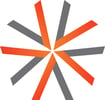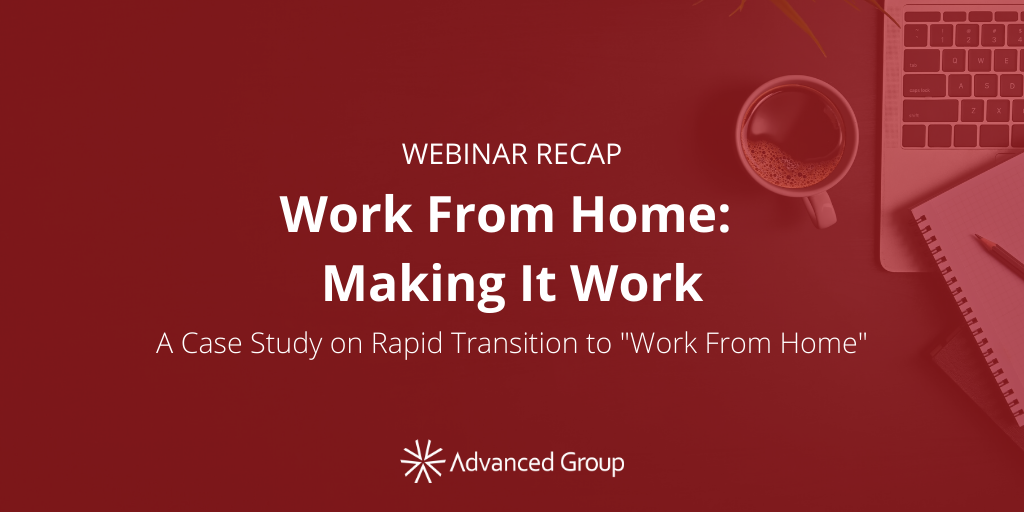
Advanced Clinical

What does it take to transition your workforce to “work from home?” How do you set your employees up for success? How do you keep employees engaged and productive? We explored these topics and more on our exclusive webinar on March 26.
Background
Advanced Group is a family of four businesses: Advanced Clinical, Advanced Resources, Advanced RPO, and WunderLand Group. Our companies specialize in consulting, staffing, and outsourcing and we have more than 500 employees in 9 countries around the world. Our workforce is highly collaborative and in addition to our internal team, we employ thousands of consultants and temporary employees.
Our Timeline
Although we don’t have any employees in Asia, we do have employees in Europe so our sensitivity to the coronavirus was heightened at an early stage. Then, in late February we experienced a couple of potential virus exposures. Our executive team was already discussing the "what if" scenarios as news about the virus was unfolding, seemingly by the hour.
First, we decided to cut all non-essential business travel and shortly after, we cut all team gatherings and outings. Finally, on 3/12 we announced that all employees would begin working from home as of 3/16 (see below for our Employee Preparation Checklist). On 3/13 we communicated our COVID-19 plans to all consultants and clients, and on 3/16, 100% of our internal employees began working remotely.

Success Factors
Our webinar on 3/26 focused on several of the critical success factors that allowed us to quickly mobilize our workforce:
Be Clear About Priorities – for Advanced, like most companies, employee health and safety are the #1 priority. This clarity frees you to be swift and decisive about the actions you need to take.
Create a Business Continuity Team – we established a cross-functional Business Continuity Team that meets daily to keep communication lines open and to raise issues we need to address. This is perhaps the most important and effective thing we’ve done.
Consider Each Function of Your Business – work-from-home needs might vary by each function in your business. Your sales employees will have different needs than your IT employees or your accounting team. Look at each function and plan accordingly to minimize business disruption.
Use Multiple Communication Channels – we rely on four different communication channels: email, our internal intranet, Workplace (by Facebook), and our emergency text messaging system. We also rely on our leaders to cascade information to their teams. Multiple channels increase the likelihood that our employees will understand what’s taking place.
Consider Cybersecurity – we could conduct an entire webinar solely on the technology aspects of workforce mobilization. One of the most important factors, however, is cybersecurity. We already had a phishing education program in place but we revitalized it prior to sending our workforce home. Culprits are likely to ramp up their malicious efforts during a time of crisis, so we're taking extra steps to strengthen our security.
Focus on Culture & Engagement – Managers need to check in 1-1 with each employee and talk about how they’re doing as people experience different challenges when working from home. Some employees crave interaction and they miss being together in the office. Some employees might be trying to balance work with the impact of school and daycare closures, making time management and the ability to focus particularly challenging.
Make sure leaders connect with each employee and check on their well-being.There’s nothing more powerful than simply asking, “how are you doing?” or “are you ok?” Personal check ins, daily meetings, and virtual group meetings all help employees feel more connected and supported.
Learn as You Go – we’ve been responsive to the COVID-19 situation but we’re not doing everything perfectly. Give yourself grace; this situation is unprecedented for everyone. One thing we have relied on is our business continuity plan and team, which has shone a light on how critical it is to have a crisis plan in place before you need it. One of our biggest challenges has been crafting internal and external communications; having those templates in place will help us in the future should we ever face another crisis.
Remember Compassion – this pandemic is impacting people in a variety of serious ways. People are worried about the economy, their own finances, their health, and the safety of their loved ones. We’ve learned that the most important thing is to be compassionate, transparent, and open with employees.
 In Closing
In Closing
We appreciate the engagement and questions from the attendees who joined us for our webinar. Please let us know if you have any questions or feedback. We hope we’ll all be on the other side of this pandemic soon; in the meantime, we hope you and your families remain healthy and safe.
Click here for the complete recording of “Work From Home: Making it Work.”